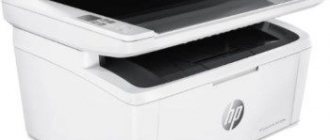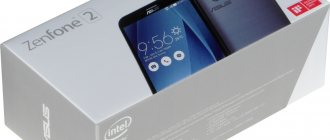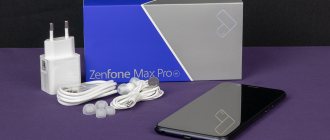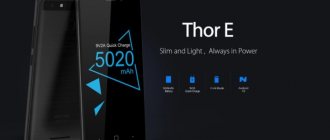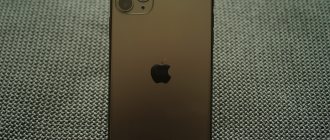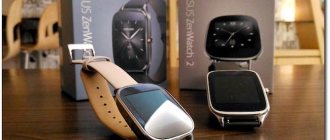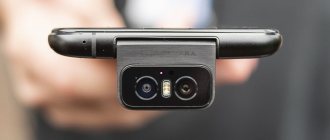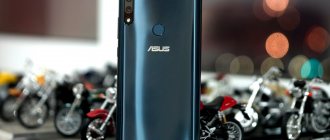A little taxonomy first. To write the headline you see in front of you, I had to step on my own throat - there are few words I like less than “phablet”. But for surgical accuracy of description this is, unfortunately, necessary. This is exactly it, a gadget stuck 0.2 inches away from becoming a tablet. But at the same time, it has definitely ceased to be a smartphone. There are not many like him: someone suggests calling phablets - or, a little more ironically, lampshades - devices with displays with a diagonal larger than 5.5 inches (starting with the iPhone Plus series), but these have long been normal , ordinary smartphones. However, there are phones with screens larger than six inches - I propose to classify them as a subclass of phablets.
Well, ASUS Zenfone 3 Ultra can be considered a bright representative of this class. It received a platform of medium-high power by today's standards Qualcomm Snapdragon 652, 3 or 4 GB of RAM depending on the modification, 64/128 GB of flash memory. Its main distinguishing features, in addition to the gigantic display, are the stated serious multimedia capabilities: True2Life+ technology should optimize the image, and stereo speakers with multiple magnets, an NXP Smart AMP amplifier and the proprietary SonicMaster 3.0 software processing system should help with sound. Also here, for the first time in the world, DTS Headphone:X surround sound technology is used. That is, in fact, we are really dealing with the closest relative of tablets, which were conceived as bedside gadgets for web surfing, games and watching videos. Let's see how Zenfone 3 Ultra combines this aspect with the fact that it is, in fact, also a phone.
Specifications
- Screen: 6.8'', IPS, 324 ppi, 1920 x 1080;
- Operating system: Android 6.0 Marshmallow (ZenUI 3.0);
- Processor: Qualcomm Snapdragon 652, Cortex-A72, 4 x 1.8 GHz, Cortex-A53 4 x 1.4 GHz;
- GPU: Adreno 510, 550 MHz;
- RAM: 3 GB (4GB);
- Built-in memory: 64 GB (128 GB) supports microSD memory cards up to 128 GB;
- Cameras: 23 MP (ƒ/2.0, hybrid autofocus, dual LED flash, optical stabilization, 4K video), 8 MP;
- Battery: 4600 mAh, non-removable;
- Dimensions: 186.4 × 93.9 × 6.8 mm;
- Weight: 233 g;
- SIM slots: 2, nano-SIM, micro-SIM, hybrid slot;
- Communication: GSM 850 / 900 / 1800 / 1900 MHz, HSDPA 800 / 850 / 900 / 1900 / 2100 MHz, LTE band 1 / 3 / 5 / 7 / 8 / 18 / 19 / 20 / 26 / 28 / 38 / 39 / 40 / 41, Wi-Fi 802.11a/b/g/n/ac, Bluetooth 4.2, GPS (A-GPS), GLONASS, BeiDou;
- Sensors: light, proximity, accelerometer, gyroscope, magnetometer;
- Available colors: Glacier Silver, Titanium Gray, Metallic Pink;
- Cost at the time of testing: from 43,000 rubles.
Hardware
At first glance, the “stuffing” of smartphones does not stand out in any way, but the devil, as they say, is always hidden in the details. The insides of the devices are as similar as the outside: both have the latest model of the Qualcomm Snapdragon single-chip chip, 625 in the smaller device and 652 in the larger one. The frequency of the “younger” model, oddly enough, is slightly higher, and this is not a mistake - the “older” one is still in the lead in terms of computing power, performance tests indisputably confirm this. Eight 64-bit cores are used, so the test results inspire respect and allow both models to compete on equal terms with the famous flagships of the smartphone industry. 4 GB of RAM is simply huge by the standards of portable gadgets.
The screen in both cases has Full HD resolution despite the noticeable difference in diagonal - 5.5 and 6.8 inches, respectively. It is reasonable that Asus did not follow fashion and install a 4K resolution screen in a larger device; this would not be justified in this case. Gorilla Glass 4, again the latest generation, is used as a protective coating. Of course, it may not withstand a hit against a brick, but it will protect against scratches twice as much as the previous generation of glass. The oleophobic surface makes fingerprints almost invisible. The only pity is that there is no anti-reflective coating - this increases the apparent brightness of the image, but glare from bright light sources will be clearly visible on it. Sticking a film is not a solution, otherwise goodbye, oleophobicity, and hello, scratches. Automatic brightness adjustment works flawlessly on the Zenfone and slightly lowers the brightness on the Zenfone Ultra, apparently to reduce power consumption of the huge screen. Color rendition and viewing angles deserve special attention. The displays use a high-quality IPS matrix, which provides a clearly visible image from almost any conceivable angle (the stated viewing angles are 178° on both axes), and also has a color gamut of 95% of the NTSC palette - a parameter previously provided only for desktop monitors. It is also possible to connect a large external monitor via an additional adapter connected to the USB port.
Wireless modules support all conceivable standards: Wi-Fi in the “younger” model can operate using the 802.11b/g/n and ac protocols, in the “older” this set also includes the 802.11a protocol, which is not very relevant in our country. Bluetooth 4.2 supports Wi-Fi direct mode. The cellular module operates in HSPA+ and DC-HSPA+ modes in 3G networks, providing the ability to download data at speeds up to 42 Mbit/s, and LTE Cat6 in 4G networks, providing speeds up to 300 Mbit/s (note that the latter is only applicable to the “Asian” version of Zenfone, and the “European” version only works with LTE Cat4 at speeds of no more than 150 Mbit/s; this does not apply to Zenfone Ultra). The “European” version of Zenfone we sell supports LTE network channels numbered 1, 2, 3, 5, 7, 8, 20, and Zenfone Ultra also supports channels 18, 19, 26, 28, 38, 40 and 41. Receiver satellite navigation is capable of receiving signals from all navigation systems: American GPS, Russian GLONASS and Chinese BeiDou. It is strange that there is no NFC module - it is present only in the ZenFone 3 Deluxe, which we are not considering in this review. But there is an infrared LED that allows you to use your smartphone as a remote control for your TV and other household appliances. There is also an FM radio; as usual, a headset or headphones play the role of an antenna.
Equipment
At first glance, the packaging of the new product resembles the box in which the Asus ZenFone 3 is sold. The same black and blue cardboard and the model name pressed on top. The same list of contents: smartphone, stickers with barcodes, user manual, “clip” for removing SIM cards, charger (5.9V 2A), USB Type-C cable and wired headset with a set of additional ear pads (3 pairs) - so you won't notice the differences.
It's a different matter when you unbox the Zenfone 3 Ultra. The flap of the box is held in place by magnets, the smartphone is enclosed in an envelope made of thick plastic, the tray with accessories slides out, just pull the tab on the side of the box. The headset is stored in a separate case. It is by no means as simple as it usually is. ASUS did not skimp on accessories and placed ZenEar S headphones with metal cases and a successful anatomical shape on a silicone pad.
⇡#Autonomous work
ASUS Zenfone 3 Ultra uses a battery with a capacity of 17.5 Wh (4600 mAh, 3.8 V). This is not a record for gadgets with such a large display - but this, combined with a well-optimized platform, is quite enough for the device to easily last a day on a single charge. You should expect more only if you use it very moderately - not as a main tube.
In our traditional test with HD video playback at maximum brightness, with the wireless connection turned on, with active updates, the Zenfone 3 Ultra lasted 7.5 hours - remarkable for an almost seven-inch gadget. You can easily count on it as a multimedia player in any situation - from home to a long flight.
Here, as in all third-generation Zenphones, a USB Type-C connector is used, but without support for the USB 3.1 standard, you should not expect ultra-high data transfer speeds. In this case, the main bonus from this connector is its symmetry and modernity. However, the Ultra supports fast charging (Qualcomm Quick Charge 3.0 in action), the battery reaches 60% in 45 minutes, the characteristics do not lie. A full charging cycle takes approximately two and a half hours when using a proprietary adapter.
Appearance
The dimensions of the ASUS Zenfone 3 Ultra are striking. 186.4 × 93.9 × 6.8 mm - in terms of dimensions, the phablet resembles a notebook or diary and occupies the same place in the life of the owner - in the inner pocket of a jacket or jacket. Despite the thin body, which even gives the device a certain elegance, there is nothing to think about operating this smartphone with one hand. Even a special function that reduces the interface scale and moves it to the edge of the screen will not help you. You have to reach for the volume keys on the rear panel.
The monolithic metal body is executed simply perfectly. In Titanium Gray, the all-in-one looks great and doesn't show fingerprints. The antennas here are placed in small white inserts visible along the edges of the front panel. If ASUS didn’t hurry up and patent this design solution, we’ll soon see these in many smartphones.
At the bottom there is a protruding mechanical key with a built-in fingerprint sensor, flanked by backlit touch buttons. Next to the earpiece you can see sensors, a front camera and an LED notification indicator. At the bottom end of the device there is a USB Type-C port and a microphone framed by two speakers. The second microphone and 3.5 mm jack are on the top panel. And finally, let's turn our attention to the camera. It protrudes slightly from the body and is equipped with a dual-tone flash and laser autofocus.
Display
The display is protected by Corning Gorilla Glass 4. It does not have a fashionable curve, but there is no edge around the perimeter - the glass smoothly merges into the metal frame, so you don’t notice the border by touch. The front panel is covered with a good grease-repellent layer. The screen sandwich houses a touch layer that recognizes 10-finger input and a polarizing filter that cuts off glare.
The IPS matrix has a diagonal of 6.8'' with a resolution of 1920 x 1080, which in total gives 324 ppi - the average pixel density per inch. The brightness of 409 cd/m2 is not a record, but despite this, the Zenfone 3 Ultra screen stands out from its competitors. Wide viewing angles, an imperceptible glow effect, the absence of spurious shades, color distortions, and high contrast make the picture very attractive.
ZenFone 3 Ultra ZU680KL smartphone review
ZenFone 3 Ultra ZU680KL is a phablet that was announced by the company in May 2020. Its diagonal is 6.8 inches, so the device is as close as possible to the external dimensions of small tablets. Among the differences, one can also note video and sound reproduction. For the first, True2Life+ technology is used with image correction, and several software and mechanical features are involved in the sound.
TECHNICAL SPECIFICATIONS
> Data transmission: LTE, 3G, 2G. > Screen: 6.8-inch diagonal, pixel density 1920×1080, support for working with gloves, Corning Gorilla Glass 4. > Matrix type: IPS, capacitive, up to 10 simultaneous clicks. > Software: Android 6.0 with proprietary ZenUI 3.0. > Power: 4-core Qualcomm Snapdragon 652 chipset, Adreno 510 graphics accelerator. > Storage: RAM 2/3 GB, built-in 32, 64, 128 GB. > Battery: built-in 4600 mAh lithium-ion, support fast charging. > Camera: main 23 MP with f/2.0 aperture, triple autofocus; 8 megapixel front with f/2.0 aperture.
SET
The device is packaged in a large, well-designed box with pull-out elements.
Inside, in addition to the main one, there is a charger, an adapter, a key for removing SIM cards, as well as documentation. A separate case with headphones and additional ear pads is included.
ERGONOMICS - USE
The appearance of the device is partially taken from its predecessors, for example, instead of a fingerprint scanner on the rear panel there is a combined sound control key, which is found only in Asus. However, the fingerprint sensor is located along with the home button on the front panel.
Despite the fact that the device may seem quite huge, its thickness is only 6.8 mm. The manufacturer designed the antennas in such a way that they cannot be seen on the body, which is cut from solid aluminum.
ZenFone 3 Ultra is available in several colors : gray, one-off, and also silver. In all variants, the device looks attractive, and the non-collapsible frame is quite resistant to fingerprints. The front side is protected by Gorilla Glass 4, so it is truly stronger than other parts. There is no resistance to water and dust, and a strong fall may leave dents.
The design of the device is perceived ambiguously due to its large dimensions, since all the attractive aspects are lost. Use with one hand is completely impossible, regardless of the size of the palm.
CAMERA
The front lens is equipped with a resolution of 8 megapixels with f/2.4 aperture, as well as manual focusing without flash. In practice, there are many options for selfies in the form of settings, however, the quality of the photos is at an average level. In general, the camera loses a little in comparison with the main model of the device.
The rear lens has a resolution of 23 megapixels with f/2.0 aperture, as well as automatic focusing, which consists of three: manual, laser and tracking. The module provides two types of stabilization: optical and digital, as well as a function from the manufacturer PixelMaster. You can also take 4 frames at the same time, then combine them and get a better photo.
DISPLAY
Asus ZenFone 3 Ultra ZU680KL uses an IPS matrix with a pixel density of 1920×1080 and a diagonal of 6.8 inches.
The surface of the front panel has an oleophobic coating. In addition, technology is used to enhance the sharpness and quality of images using programs and components.
Tru2Life+ enhances natural color reproduction and detail for a more refined screen reading experience. The “blue filter” contributes to its moderate brightness, making the eyes less tired, while the original parameters of other colors remain the same. The pixel density per inch is not very high, but the images and viewing angles show excellent results.
OPERATING SYSTEM
The device runs on Android 6.0.1 software along with the proprietary ZenUI 3.0. The variations are quite new and adapt well individually to Asus gadgets.
Traditionally, there is the possibility of advanced customization, that is, you can customize the interface as you wish with many options.
In addition, there is a built-in “device manager”, which is responsible for security, optimization, memory and more.
AUTONOMY
Uses a built-in 4600 mAh battery. Considering the dimensions of the display and a sufficient level of optimization, the device can be used throughout the day in active use.
The result can only be increased by reducing the load. Fast charging function is also supported.
CONCLUSION
Based on the technical characteristics, the Asus ZU680KL smartphone is not very productive, but in practice the results are suitable for any task. With such a diagonal, the screen is not equipped with a QHD resolution, which is compensated by the IPS matrix, as well as many different technologies that really improve the quality. Most programs run in tablet mode, so there are no problems with adapting images. The application interface is also perfectly proportional to the display size. In addition, the launch and activation speed is almost instantaneous.
Despite its great functionality, the camera is not ideal for professional photography, but the presence of three focusing options, dual stabilization, and high resolution is quite enough for the user. In this case, the settings can be adjusted independently, and filters contribute to individual situations.
Autonomy is quite sufficient with a capacious battery and support for fast charging. The design is quite good and moderate, the frame is thin. The device is therefore very practical for two-handed use.
>Dear friends! We ask you to leave feedback on the use of Asus Ultra smartphones in the comments below. For objective user opinion. Thank you in advance!
Iron
ASUS Zenfone 3 Ultra received an eight-core Qualcomm Snapdragon 652 processor with an Adreno 510 graphics core, 3 GB of RAM and 64 GB of storage in the configuration reviewed. Of these, 50 GB are free. In terms of all its characteristics, the smartphone comes close to the flagships of this season, while in terms of performance it occupies a firm position in the middle of the top segment.
Of course, there is no talk of any lags in the interface or applications. There is no throttling either. Zenfone 3 Ultra can handle any mobile games. Most of them work at maximum settings. We tried Modern Combat 5, Dead Trigger 2, Mortal Combat X, World of Tanks - they all worked great, even while simultaneously recording gameplay using the built-in software.
Unfortunately, it was not possible to obtain accurate FPS and temperature values during the game. Applications used for this cause Zenfone 3 Ultra to reboot.
⇡#Hardware and performance
The Ultra uses the Qualcomm platform, like other third-generation Zenfone - the mainstay of Intel's mobile division has given up. In this case, we are talking about a Snapdragon 652 system-on-chip (MSM8976) with eight cores: four ARM Cortex-A72 clocked at 1.8 GHz and four ARM Cortex-A53 clocked at 1.4 GHz. The system is made using a 28-nm process technology and, naturally, supports 64-bit computing. Graphics core – Qualcomm Adreno 510 clocked at 550 MHz.
It’s not a bad platform at all, which ensures stable operation of the device when performing the vast majority of tasks. You can run even the most resource-intensive games on the Zenfone 3 Ultra - but exactly what to run, there is no talk of ideal display smoothness at maximum settings, despite the fact that the picture needs to be calculated only for Full HD resolution. In general, games with maximum graphics quality are the prerogative of top platforms, like the Snapdragon 800 series. Yes, this is not a flagship solution in terms of performance. On the other hand, the smartphone confidently copes with video of any resolution (up to 4K inclusive) - it plays its main multimedia role brilliantly.
Unfortunately, I cannot report on the ideal stability of the system. Several times the device went into a dead dive when performing simple tasks (a couple of times in the camera application, once in the browser) - this was treated either by forcefully clearing the cache or by rebooting the device. Overheating was not tactilely felt - these were probably software errors associated with the Zen UI shell.
There are two versions of Zenfone 3 Ultra: with 64 and 128 GB of non-volatile memory on board. The first of them is also equipped with only 3 GB of RAM, the second – 4 GB. Taking into account the presence of a slot for a memory card, albeit combined with a slot for a second SIM card, as is now the norm, this is a completely normal order of things.
Software
Based on Android 6.0, ASUS created its own version of the operating system. It is nicely designed in a single style and equipped with a new set of animations. We especially liked the parallax effect on the desktop - depending on the position of the device, tracked using the accelerometer, the wallpaper moves slightly.
We talked in detail about the functionality of ZenUI 3.0 in our review of ASUS Zenfone 3. Here we note that some menus are overloaded and, in general, are not intuitive. It seems that the company's programmers are losing their sense of proportion. Thus, during the initial setup of the device, the user is asked to install many programs from partners, but even if you refuse all of them without exception, you will be greeted by a system filled with unnecessary software (more than a dozen shortcuts). Not everything can be removed from this “wealth” using standard means. From time to time, applications remind you of their existence with intrusive notifications. This is somehow not respectable on ASUS's part.
What's worse is that the system in its current form is unstable. Sudden reboots occurred not only when trying to read information about FPS in games, but also several times simply while charging the device.
Connection
There are 14 supported LTE bands alone in the specifications of ASUS Zenfone 3 Ultra. With such a set of frequencies, you will not be left without high-speed Internet in any developed country in the world.
The case has two holes for SIM card trays. The first, designed for the nano format, is combined with a slot for Micro SD, while the second is designed for a micro SIM card. There is only one radio module, even despite the small area allocated for antennas - signal reception is always stable. The same goes for dual-band Wi-Fi 802.11a/b/g/n/ac and Bluetooth 4.2 and even FM radio. Unfortunately, there is no NFC support.
The call management menu, in addition to the phone book, dialer with light and dark design options, contains an item responsible for recording calls from the line.
A cold start when you first start navigation is quick only if you are connected to the Internet. For the first time, the smartphone updates its satellite database using A-GPS. There is no need for this in the future, and navigation starts in a matter of seconds. The number of connections is high, the smartphone finds contact with all three global positioning systems: GPS, GLONASS and BeiDou.
USB Type-C in Zenfone 3 Ultra uses the USB 2.0 protocol, supports USB OTG and acts as a Display Port.
Sound
In this case, it’s worth talking about sound separately. ASUS paid great attention to this aspect, which resulted in the installation of loud stereo speakers with a resonance chamber and an NXP Smart Amp amplifier. They play cleanly and are most suitable for multimedia entertainment: movies and games.
In addition, there were also software improvements. Thus, presets adjust the nuances of sound to specific branded headphones, an equalizer is built into the firmware, as well as DTS Headphone: X technology, which emits seven-channel sound. This makes Zenfone 3 Ultra a good choice for audiophiles.
⇡#Display and sound
This time, ASUS did without additional versions of the device with different display diagonals, as was the case with Zenfone 3, limiting itself to “only” options with different amounts of RAM and flash memory. Both have the same screen: a 6.8-inch LCD with an IPS matrix, the resolution of which is 1920 × 1080. The use of Full HD resolution seems logical from the point of view of energy saving and saving computing resources - this is still not a top-end system-on-a-chip . But by declaring (including the price) the flagship status of the Ultra as a multimedia device, ASUS has confronted itself with the need to provide extremely high-quality images. And this is not combined with pixelation that is quite noticeable to the naked eye - the pixel density is 324 ppi. This is as much as 2 ppi less than Retina screens from the time this term appeared, and people have since gotten used to sharper displays.
Of course, there is both a polarizing layer and an oleophobic coating - when direct sunlight hits the glass, the screen still glares, but not entirely critical. The touch coating responds to ten simultaneous touches and fully supports multi-touch gestures.
But let's return to the direct characteristics of the display. It does not differ in extreme brightness - 409 cd/m2. But for the main scenarios for using the gadget, which involve playing games and viewing content in a quiet environment, particularly high brightness is not required. If necessary, on a sunny day it is quite possible to see what is happening on the screen. Viewing angles are traditionally wide for IPS: the contrast drops noticeably, but colors are not distorted; it’s comfortable to watch something on the Zenfone 3 Ultra together. Due to the size of the screen, it is perhaps more comfortable than on any other smartphone.
The contrast is impressive - 1508:1. This is a remarkable indicator for an LCD display. Black luminosity level – 0.23 cd/m2. There are no visible problems with the uniformity of illumination; there is little glare at the edges.
ASUS Zenfone 3 Ultra, color temperature. Blue line – Ultra indicators, dotted line – reference temperature
ASUS Zenfone 3 Ultra, gamma. Yellow line – Ultra indicators, dotted line – reference gamma
The display is set up quite well, similar to what we saw in Zenfone 3. Unfortunately, the non-disabled image “enhancers” noticeably affected the measurements - for example, gamma could not be calculated correctly. But we got a general idea of the behavior of the Zenfone 3 Ultra screen. Color temperatures range on average from 6500 to 7500 K - colors look a little colder than they should. If desired, you can slightly correct the color rendition in the settings, shifting the balance towards red or blue shades. There is a software blue filter that automatically makes the picture warmer. Many people recommend turning it on before bed to prevent your eyes from getting tired, but you can use it more often.
ASUS Zenfone 3 Ultra, color gamut. Gray triangle – sRGB coverage, white triangle – Ultra coverage
In terms of color accuracy, Zenfone 3 Ultra is still slightly behind the “small” Zenfone 3, which is a pity - this is critical for it. Nevertheless, there is nothing really terrible: the average deviation of DeltaE on the Color Checker scale, which includes both a wide range of colors and shades of gray, was only 4.41 - it does not fit into the standard, but it does not deviate too much from it. Pay attention to the color gamut, which is significantly superior to standard sRGB.
If necessary, many display parameters can be adjusted to suit you.
If desired, you can connect the Ultra to a monitor or TV and use it simply as a media center - the USB Type-C connector here can work as a Display Port.
The ASUS Zenfone 3 Ultra is quite impressive as an audio player. Firstly, it can adapt to headphones, significantly changing the sound picture when choosing their type - and you can also choose specific branded headphones. Secondly, the sound is generally very good: excellent detail, confident processing of the entire frequency spectrum without dips, a considerable power reserve - there is no need to turn low-impedance headphones to maximum volume. Virtual 7.1-channel sound according to the DTS Headphone: X standard is supported - this is a completely unique feature of the device. Overall, the Zenfone 3 Ultra is one of the best sounding smartphones I've tried.
Stereo speakers are used here, which are also very loud and powerful - however, you shouldn’t seriously count on them. The call will be heard from afar, but you should play music through external speakers. Although you can watch the film together.
Camera
We again refer you to the Zenfone 3 review, which has already described in detail the rich functionality of the camera application, which this time processes data coming from 23 MP and 8 MP sensors.
The slogan on the site says “Photos that look like the real world” and this is true - the emphasis here is on naturalness. While other manufacturers set up algorithms in such a way that they embellish the picture, natural colors and small details are preserved here.
Focusing is fast and accurate, and a series of photos appear in the gallery without delay. You only need to wait to receive “Super Permission”. In this mode, the smartphone combines several frames into one at as much as 92MP.
Zenfone 3 Ultra is one of the few smartphones that makes sense to take photos in the dark. This purpose is served by: bright flash, HDR and low light mode.
“Low Light” increases the light sensitivity of the sensor without increasing shutter speed and allows you to achieve softer, grain-free images. HDR is better suited for scenes with low ambient light and moving objects. It doesn't perform as well in night scenes filled with light sources, like a streetlit street. In this case, it is better to rely on automation.
